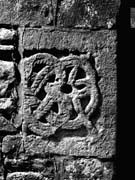Select a site alphabetically from the choices shown in the box below. Alternatively, browse sculptural examples using the Forward/Back buttons.
Chapters for this volume, along with copies of original in-text images, are available here.
Object type: Part of a cross-shaft(?)
Measurements: H. 45.5 cm (18 in); W. 34 cm (13.5 in); D. 16 cm (6.25 in)
Stone type: Pale grey (N7), matrix-supported, sparsely shelly limestone. Ooliths are in the range 0.3 to 0.9 mm diameter, but most fall between 0.5 and 0.6 mm. Elongate shell fragments are up to 8 mm across. Ooliths weather out to give 'aero-chocolate' texture; some 'watermarks'. Bath stone, Chalfield Oolite Formation, Great Oolite Group, Middle Jurassic
Plate numbers in printed volume: Pls. 200-1
Corpus volume reference: Vol 7 p. 147-8
(There may be more views or larger images available for this item. Click on the thumbnail image to view.)
A: There are wide flat-band mouldings on three sides, which have been rubbed down since they are on a lower plane than the carving they enclose. A slightly scalloped effect in the top right could have been a row of pellets. The interior space is filled with a composition of two ribbon animals whose bodies loop and cross, and taper into incised tails which loop at the top. The body of one beast is ribbed with a herringbone pattern and incised central groove, and the other has incised zig-zags (width of bodies c. 5 cm).
B: Plain and recut with traces of plaster
C and D: Not visible
This piece is part of the West Saxon ribbon animal group (see introduction p. 42), but as Plunkett noted it is most akin to the ribbon animals on the Colyton shaft in Devon (Ill. 7), since unlike the others these creatures are not outlined (Plunkett 1984, II, 281–2). Since the plant ornament on Chew Stoke 2 is also closely similar to Colyton, there is a fair presumption that these panels are part of the same shaft, with a similar range of patterns as those which appear on the Devon cross. See below under Chew Stoke 2 for further discussion.



